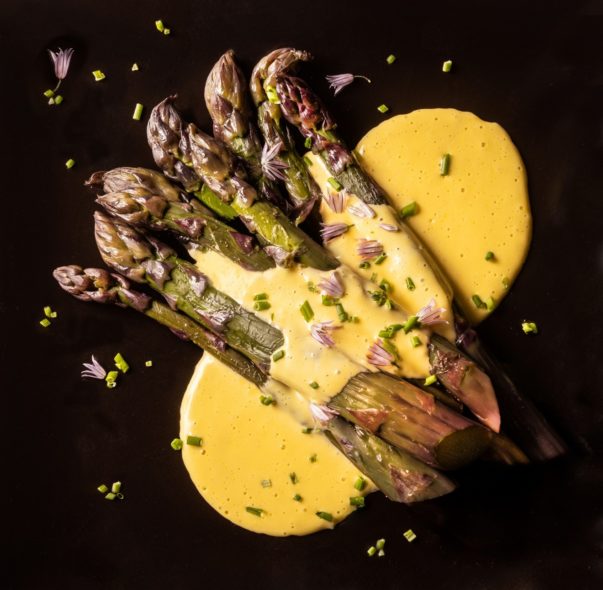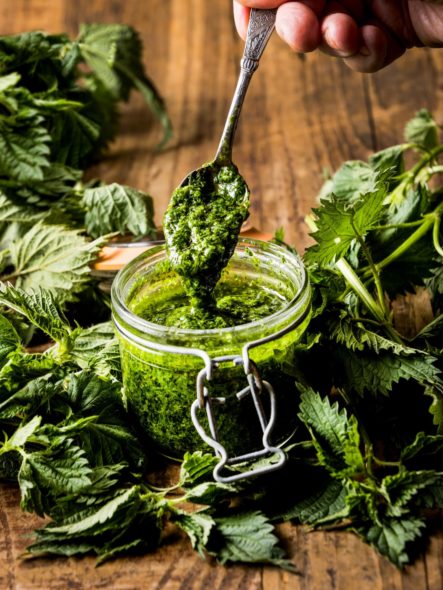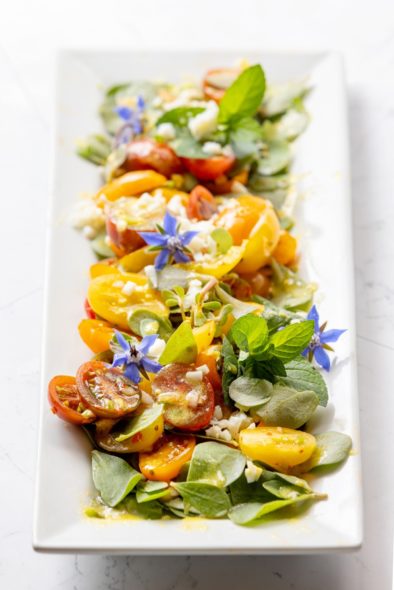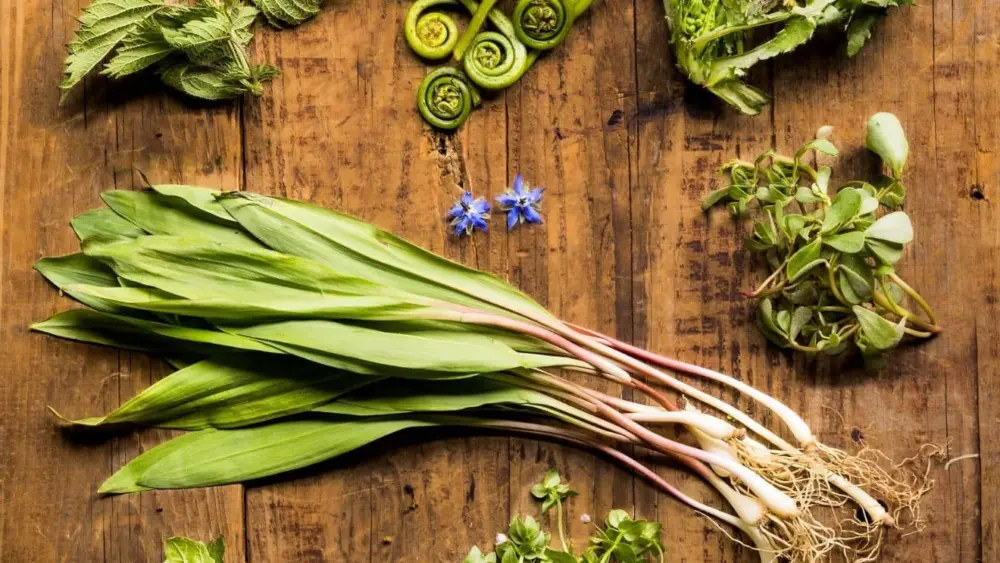Disclaimer: I hate to begin with a disclaimer, but it is necessary, so here goes:
To the best of my knowledge, the information contained herein is accurate. I must stress, however, that you do not eat any wild edible plants, herbs, weeds, trees or bushes until you have verified with your health professional that they are safe for you.
WILD ASPARAGUS
I give a tip of the hat here to Euell Gibbons whose 1962 book “Stalking the Wild Asparagus” opened my eyes to wild food. Asparagus has an interesting history. It grew wild along the Nile. It was a delicacy to the Greeks, who introduced it to the Romans. The Romans fell in love with it and sent fleets around the Mediterranean to collect it. It was brought to America by colonists where some escaped from the garden and spread in the wild.
If ever there was a harbinger of spring, it’s asparagus. As the days grow longer and the soil warms, asparagus suddenly springs into life sending up shoots that can grow 6 inches or more a day. At its peak asparagus can grow almost faster than it can be harvested. This vitality has, over the ages, put it high on the list of foods which have special powers to increase potency and sexual vigor!
A member of the lily family (along with onions, garlic and shallots) the plants take three years of growing before they begin to produce edible shoots. The plant is perennial and will continue to produce for up to 20 years.
Size really doesn’t tell you much unfortunately. The conventional wisdom is that thin, pencil size asparagus are more tender than those that are fatter. Truth is that diameter of the stalk isn’t a good guide to its tenderness. Actually, the fatter the spear usually is more tender. The reason: No matter what its size, each spear has a set number of tough fibers that run its length. In a small spear they are crammed together and there is less juicy white flesh between them. With fatter spears the fibers are further apart separated by more tender, sweet flesh.
ASPARAGUS WITH HOLLANDAISE SAUCE
Serves 4
This is the classic French recipe for asparagus. Cook the asparagus in whatever way you like but make sure it’s crisp-tender.
1-1/2 pounds asparagus, preferable wild gathered
1/2-pound (2 sticks) butter
3 egg yolks
1 tablespoon lemon juice or to taste
3 tablespoons or so warm water
Salt and freshly ground white pepper
Chopped chives and paprika for garnish
Using a collapsible steamer steam asparagus until just tender, about 5 minutes depending on thickness.
Meanwhile melt butter in a 1-quart saucepan over medium heat. Remove from heat and skim off any foam.
Add egg yolks, lemon juice and 1 tablespoon warm water to a blender and blend for a couple of seconds. With motor running at medium speed add half the butter in a slow steady stream. Add 1 tablespoon water to thin sauce and continue slowly adding remaining butter. Thin sauce if desired with additional warm water and season to your taste with salt and pepper. Serve warm asparagus topped with a spoonful or two sauce and garnished with chives and paprika.

DANDELIONS
The dandelion (Taraxacum officinale) is probably the most recognized plant in North America. Dandelion gets its name from the French “dent de lion” or lion’s tooth, because of the saw-toothed edges of dandelion leaves. Early settlers looked forward to dandelions because they were usually the first greens of spring, and because they provide a useful tonic for the digestive system and the liver. My grandmother ate all parts of the dandelion for her rheumatism. The milky sap of a mature plant is believed to be useful for treating warts.
The big complaint about dandelion greens is that they are very bitter. However, as we have learned to enjoy bitter greens in North America, their place on our table has grown. Usually, I wouldn’t sit down and eat a big bowl of dandelion greens by themselves but mixed in with other greens in salads and stir fries, and they can really shine. Dandelions are popular around the world, and there are hundreds of traditional dishes that utilize them so there must be something good about them.
Despised by gardeners, the dandelion’s incredible health benefits should encourage you to try them occasionally. All parts of the dandelion are edible, including the flowers and roots. Leaves are best in early spring when they aren’t so bitter. Roots, once they are thoroughly washed, can be chopped, and steamed or stir fried, and also can be roasted to make an interesting non-caffeinated coffee substitute. Flowers are used to make wine and are pretty added to salads as is.
WARM DANDELION SALAD
Serves 4 to 6
This is an old-time “Grandma” sort of recipe that utilizes the notorious weed. Be sure to use only young and tender dandelion leaves. Older leaves can be tough and very bitter. For variety, you could add chopped oil cured olives or capers to the salad.
6 cups young dandelion leaves, well washed and stems removed
2 hardboiled eggs
2 teaspoons Dijon mustard
1/4 cup fresh lemon juice
1 tablespoon honey or to taste
1/3 cup olive oil
Salt and freshly ground pepper
Chicken or vegetable stock
2 teaspoons chopped chives
1/4-pound thick cut bacon, cut into 1/4-inch dice
2 tablespoons white wine or champagne vinegar
Dandelion flowers for garnish (optional)
Pat or spin the dandelion leaves dry, then chill them. Remove the yolks from the eggs, and mash in a bowl with the mustard, lemon juice and honey. Gradually whisk in the oil until a smooth dressing is formed. Season to your taste with salt and pepper, and thin, if desired, with a little stock, and stir in the chopped chives.
Finely dice the egg whites and set aside. In a sauté pan, brown the bacon until crisp. Remove the bacon and drain on paper towels. Discard all but two teaspoons of bacon fat. At serving time, heat the bacon fat over moderate heat, and add the vinegar scraping up any browned bits. Quickly toss the greens with the mustard dressing, and then add to the pan to very briefly coat with the vinegar mixture. Place on plates, and top with the diced egg whites, bacon and flowers, if using. Serve immediately.
FIDDLEHEAD FERNS
Fiddleheads are an early spring delicacy with a very short season. Resembling the curved head of a violin, fiddleheads are the young, coiled fronds of the ostrich fern (Matteuccia struthiopteris). Nearly all ferns have fiddleheads, but those of the ostrich fern are unlike any other. Ostrich fern fiddleheads, which are about one inch in diameter, can be identified by the brown papery scale-like covering on the uncoiled fern, as well as the smooth fern stem, and the deep” U”-shaped groove on the inside of the fern stem. Before harvesting in the wild, make sure you can properly differentiate the ostrich fern fiddleheads from other fern fiddleheads.
Not all ferns are edible; in fact, bracken ferns are reportedly carcinogenic and should not be consumed. Look for ostrich ferns emerging in clusters of about three to twelve fiddleheads each on the banks of rivers, streams, and brooks starting in late March thru June depending on where you live. If the ferns are on private lands, always make sure that you have permission before harvesting. There are good YouTube videos on identifying and harvesting fiddleheads if you want to try them yourself. Fiddleheads have an intriguing flavor that reminds one of the unusual combination of asparagus, artichokes and okra. Their distinct taste and firm texture make fiddleheads a good match for stir-fries as well as for cheese and tomato sauces.
Cooking fiddleheads
Clean the fiddleheads in a tub of clean water, rubbing them gently to remove the brown papery covering. Fiddleheads should always be cooked before eating, and boiling or steaming is the best method. To boil: Bring lightly salted water in a pot to a rolling boil and add the washed fiddleheads. The water should fully cover the fiddleheads when added. Bring the water back to a steady boil and cook for 2 to 3 minutes. To steam: Using a steamer of your choice, steam them for 3 to 4 minutes.
I think fiddleheads are best served simply with olive oil or melted butter and a splash of lemon or vinegar. Their flavor is reminiscent of asparagus so flavor them similarly. Cooked and then chilled, fiddleheads make a wonderful addition to salads. Fiddleheads should be boiled or steamed prior to use in recipes, which use further cooking methods like sautéing, stir-frying or baking. Remember to keep fiddleheads refrigerated until you are ready to cook or preserve them. They can be stored in the refrigerator for up to two weeks.
PICKLED FIDDLEHEADS
Try these as an accompaniment to smoked meats and cheeses. Maybe even to replace the olive in your woodsman’s martini!
Cider vinegar
Sugar
1/8 teaspoon each of pepper, ground nutmeg, cinnamon, allspice and celery seed
Pour enough vinegar over the fiddleheads to cover, then strain it off into a pan. Add 1/2 cup sugar for every 2 quarts of vinegar. Add a large pinch of each of the spices and celery seed. Boil this syrup for 7 to 8 minutes; then pour over the cooked fiddleheads in pint-sized jars. Seal and process for 15 minutes in a boiling water process canner.
STINGING NETTLES
Despite the sting of their prickly leaves, stinging nettles are secretly both good tasting and good for you. The sting comes from formic acid in the hairy leaves, which is neutralized when cooked. Nettles are greens with amazing culinary and medicinal properties. They are high in iron, potassium, manganese, calcium and Vitamins A and C and are also a decent source of protein.
The word “nettle” describes more than 40 different flowering plant species from the Urtica genus, which comes from the Latin word “uro,” meaning, “I burn.” The plant is native to Europe, Asia, Africa and North America, and is found wild throughout the continental United States. Nettles are readily available in spring and early summer.
Look for young plants in spring and summer when you are ready to forage. Always pick the leaves while wearing thick gloves and a long-sleeved shirt (and pants). When foraging, only pick the nettle tops (the top four leaves) and make sure the nettles are less than knee-high. Nettles are found in woodsy areas and forests, in natural grasslands, along fertile fields and riverbanks, and along shaded trails.
To cook nettles, wash and drain, discarding the stems. Place the leaves in a pot of boiling salted water and cook for 1 to 2 minutes until nettles are wilted. Drain through a colander and press out any excess water. Nettles can be stored in an airtight container in the refrigerator for up to 5 days. Again, after cooking, nettles produce an entirely sting-free eating experience.
NETTLE PESTO
Makes 1-1/2 cups
Delicious with pasta, but also try adding nettles as a garnish for creamy soups, and fold into softened butter for a delicious topping for meats, fishes and vegetables.
5 cups or so uncooked nettles leaves and small stems
3 cloves garlic
4 tablespoons pine nuts or blanched almonds, lightly toasted
1/2 cup extra-virgin olive oil, plus more as needed
1/2 cup or so freshly grated Parmesan cheese
2 teaspoons finely grated lemon zest
Salt and pepper to taste
With tongs, place the nettles and garlic in a big pot of salted, boiling water for 1 to 2 minutes. Drain and immediately plunge into cold water to stop the cooking and to set the color. Drain again and wring dry in a clean tea towel. Coarsely chop both the nettles and garlic. You should have 1-1/4 cups or so.
In a food processor or blender, combine the nettles, garlic, pine nuts, olive oil, cheese and zest. Process in bursts to chop coarsely until a thick green sauce forms. The mixture can be as smooth or textured as you prefer. If the sauce is too thick, add a little more olive oil. Season to your taste with salt and pepper.
Pour into a glass jar or other container and top with a thin layer of olive oil to prevent the surface from discoloring. Cover tightly and refrigerate for up to 1 week or frozen for up to 3 months.

PURSLANE – THE DELICIOUS WEED
Although farmers and gardeners and the FDA usually see purslane (Portulaca oleracea) as an invasive weed, it’s a popular vegetable and herb in many cuisines, including those of China, Mexico and Greece. In Mexico, the plant is called verdolaga, and is a favorite comfort food. There, it is eaten in omelets, as a side dish, rolled in tortillas, added to salads, or dropped by handfuls into soups and stews.
Even if you don’t know the purslane name, I know you’ve seen it. Purslane is a low growing, spreading plant with succulent leaves that look a lot like a miniature jade plant. It grows just about everywhere and thrives in the warm to hot weather of late spring and summer. You can eat the entire plant: leaves, stems and tiny flowers. It has a tart, lemony flavor with juicy, almost mucilaginous texture. Look for it in sunny places with poor or disturbed soil, especially in parks and farmlands. Purslane is a very hardy plant and can even grow in cracks in the sidewalk or roadway. If you are wild gathering, be careful, of course, to avoid picking purslane around areas which are impacted by pesticides or automobile pollution. You’ll find cultivated versions in farmer’s markets during the spring and summer.
Worldwide, there are something like 19 genera and approximately 500 species of purslane. Part of the reason for its evolutionary success is that a single plant can produce more than 50,000 seeds, and those seeds can survive for up to 40 years.
Purslane was said to be Gandhi’s favorite food. According to Harold McGee, “Purslane is also called ‘pigweed’ owing to the fact that the 19th century Englishman William Cobbett said it was “suitable only for pigs and the French.” McGee also notes purslane’s tartness comes from an abundance of malic acid. Succulents like purslane convert malic acid to glucose during the day. This means purslane harvested in the morning will be tarter than purslane harvested later in the day or evening.
Purslane is very healthy for you. It has the highest amount of heart-healthy omega-3 fats of any edible plant, according to researchers at the University of Texas at San Antonio.
Fresh, raw leaves can be used in salads and as vegetable juice. Gently sautéed, steamed or stewed stems and leaves are great served as a side dish with fish and poultry. Also try it quickly stir-fried and mixed with other like-minded greens such as spinach and vegetables. Purslane is also used in soups and curries and eaten with rice.
MOROCCAN TOMATO AND PURSLANE SALAD
Serves 4
You can buy prepared harissa, but it’s better if you make your own. It’s a potent condiment, so use it with discretion.
3 tablespoons fresh lemon juice
1 teaspoon or so harissa, or to taste (recipe follows)
1 teaspoon honey, or to taste
12 ounces or so ripe cherry tomatoes, halved or quartered depending on size
1/4 cup finely chopped scallions, both white and green parts
1 cup purslane leaves
2 tablespoons chopped fresh mint
Kosher or sea salt to taste
Whisk the lemon juice, harissa and honey together, and gently combine with the tomatoes, scallions, purslane and mint. Season to taste with salt and additional harissa if desired. You can make this a few hours ahead and stored covered in the refrigerator.
Harissa
Makes about 1/2 cup
There are as many variations of the recipe for this Moroccan hot pepper condiment as there are people who make it. At its simplest, harissa is just hot dried chilies which are ground and stirred into olive oil. This version has some other flavors added to give a little more dimension. You could also add something tart like lemon, vinegar or sumac, and green herbs such as mint or cilantro.
2 cups (1 ounce or so) dried hot red chilies
2 teaspoons whole coriander seeds
1-1/2 teaspoons whole cumin seeds
2 tablespoons chopped fresh garlic
1 teaspoon Kosher or sea salt, or to taste
Extra virgin olive oil
Soak the chilies in warm water to cover until softened, about 1 hour. Drain and cut the chilies in half discarding the stems and seeds. Chop the chilies roughly and set aside.
While chilies are soaking, dry toast the coriander and cumin seeds in a small frying pan over moderate heat. They should be a shade darker and fragrant. Grind to a fine powder and set aside.
Add the prepared chilies, spices, garlic and salt to a blender. Purée, adding just enough olive oil to make help the mixture purée, about 1/3 cup should do the trick. With the motor off, scrape down sides with a rubber spatula to make sure mixture is evenly puréed. Spoon into a clean jar and top with enough olive oil to completely cover. Store covered in the refrigerator for up to one week.

Note: If you live in Sonoma County many of these ingredients are available at Oliver’s Markets supplied by the forager-farmer Wine Country Cuisine.
John Ash © 2024





